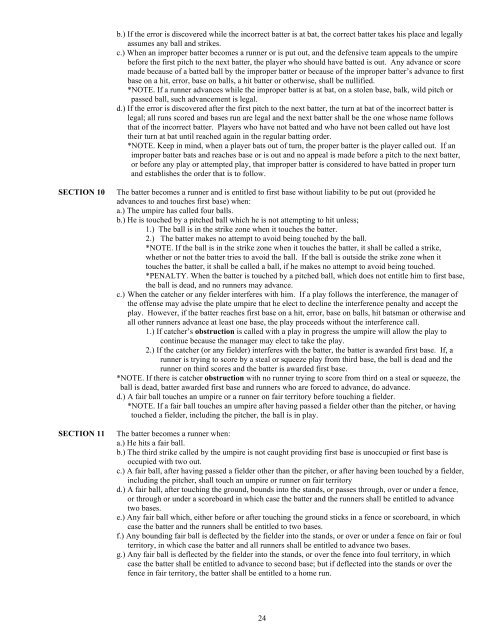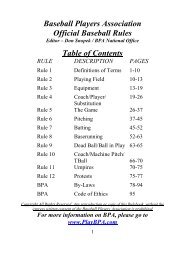baseball players association rule 1 definitions of terms
baseball players association rule 1 definitions of terms
baseball players association rule 1 definitions of terms
You also want an ePaper? Increase the reach of your titles
YUMPU automatically turns print PDFs into web optimized ePapers that Google loves.
.) If the error is discovered while the incorrect batter is at bat, the correct batter takes his place and legally<br />
assumes any ball and strikes.<br />
c.) When an improper batter becomes a runner or is put out, and the defensive team appeals to the umpire<br />
before the first pitch to the next batter, the player who should have batted is out. Any advance or score<br />
made because <strong>of</strong> a batted ball by the improper batter or because <strong>of</strong> the improper batter’s advance to first<br />
base on a hit, error, base on balls, a hit batter or otherwise, shall be nullified.<br />
*NOTE. If a runner advances while the improper batter is at bat, on a stolen base, balk, wild pitch or<br />
passed ball, such advancement is legal.<br />
d.) If the error is discovered after the first pitch to the next batter, the turn at bat <strong>of</strong> the incorrect batter is<br />
legal; all runs scored and bases run are legal and the next batter shall be the one whose name follows<br />
that <strong>of</strong> the incorrect batter. Players who have not batted and who have not been called out have lost<br />
their turn at bat until reached again in the regular batting order.<br />
*NOTE. Keep in mind, when a player bats out <strong>of</strong> turn, the proper batter is the player called out. If an<br />
improper batter bats and reaches base or is out and no appeal is made before a pitch to the next batter,<br />
or before any play or attempted play, that improper batter is considered to have batted in proper turn<br />
and establishes the order that is to follow.<br />
SECTION 10<br />
SECTION 11<br />
The batter becomes a runner and is entitled to first base without liability to be put out (provided he<br />
advances to and touches first base) when:<br />
a.) The umpire has called four balls.<br />
b.) He is touched by a pitched ball which he is not attempting to hit unless;<br />
1.) The ball is in the strike zone when it touches the batter.<br />
2.) The batter makes no attempt to avoid being touched by the ball.<br />
*NOTE. If the ball is in the strike zone when it touches the batter, it shall be called a strike,<br />
whether or not the batter tries to avoid the ball. If the ball is outside the strike zone when it<br />
touches the batter, it shall be called a ball, if he makes no attempt to avoid being touched.<br />
*PENALTY. When the batter is touched by a pitched ball, which does not entitle him to first base,<br />
the ball is dead, and no runners may advance.<br />
c.) When the catcher or any fielder interferes with him. If a play follows the interference, the manager <strong>of</strong><br />
the <strong>of</strong>fense may advise the plate umpire that he elect to decline the interference penalty and accept the<br />
play. However, if the batter reaches first base on a hit, error, base on balls, hit batsman or otherwise and<br />
all other runners advance at least one base, the play proceeds without the interference call.<br />
1.) If catcher’s obstruction is called with a play in progress the umpire will allow the play to<br />
continue because the manager may elect to take the play.<br />
2.) If the catcher (or any fielder) interferes with the batter, the batter is awarded first base. If, a<br />
runner is trying to score by a steal or squeeze play from third base, the ball is dead and the<br />
runner on third scores and the batter is awarded first base.<br />
*NOTE. If there is catcher obstruction with no runner trying to score from third on a steal or squeeze, the<br />
ball is dead, batter awarded first base and runners who are forced to advance, do advance.<br />
d.) A fair ball touches an umpire or a runner on fair territory before touching a fielder.<br />
*NOTE. If a fair ball touches an umpire after having passed a fielder other than the pitcher, or having<br />
touched a fielder, including the pitcher, the ball is in play.<br />
The batter becomes a runner when:<br />
a.) He hits a fair ball.<br />
b.) The third strike called by the umpire is not caught providing first base is unoccupied or first base is<br />
occupied with two out.<br />
c.) A fair ball, after having passed a fielder other than the pitcher, or after having been touched by a fielder,<br />
including the pitcher, shall touch an umpire or runner on fair territory<br />
d.) A fair ball, after touching the ground, bounds into the stands, or passes through, over or under a fence,<br />
or through or under a scoreboard in which case the batter and the runners shall be entitled to advance<br />
two bases.<br />
e.) Any fair ball which, either before or after touching the ground sticks in a fence or scoreboard, in which<br />
case the batter and the runners shall be entitled to two bases.<br />
f.) Any bounding fair ball is deflected by the fielder into the stands, or over or under a fence on fair or foul<br />
territory, in which case the batter and all runners shall be entitled to advance two bases.<br />
g.) Any fair ball is deflected by the fielder into the stands, or over the fence into foul territory, in which<br />
case the batter shall be entitled to advance to second base; but if deflected into the stands or over the<br />
fence in fair territory, the batter shall be entitled to a home run.<br />
24



